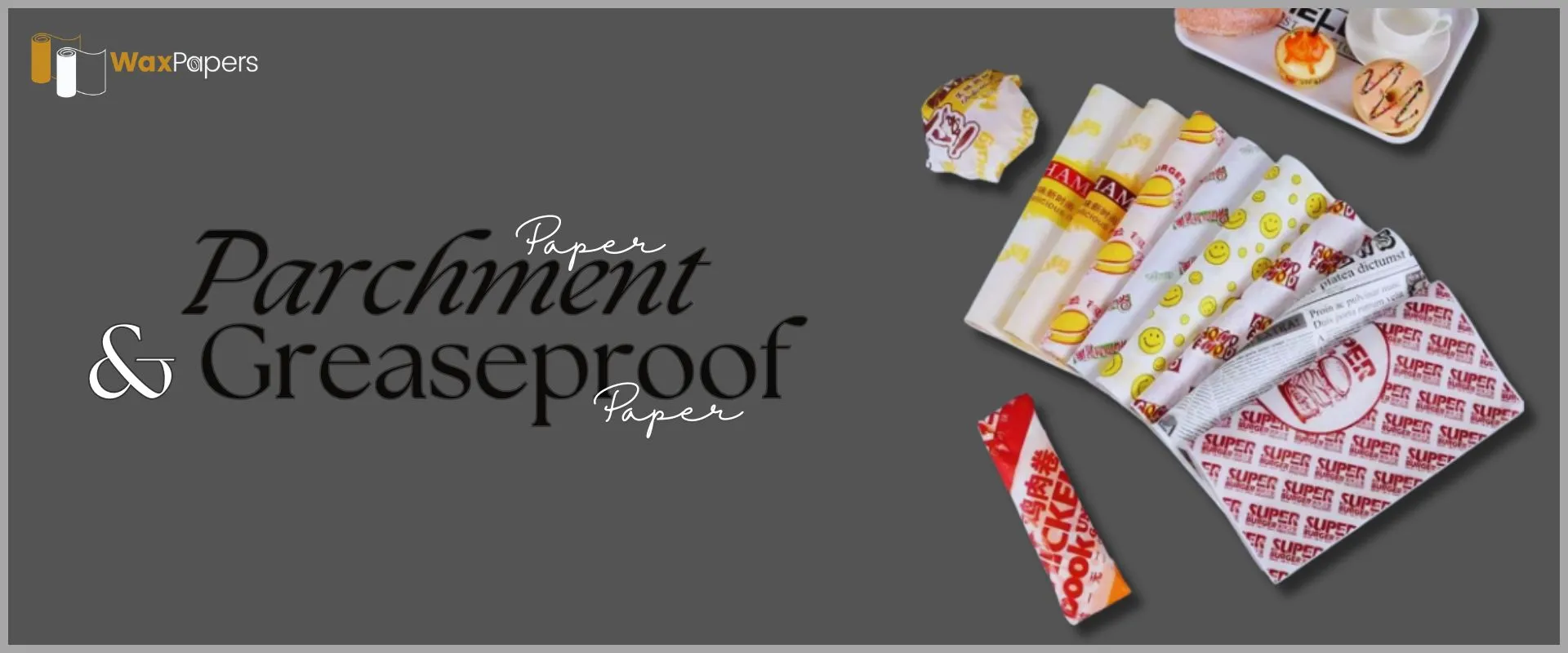
Difference Between Parchment Paper And Greaseproof Paper
June 12, 2024 Explore Blogs
At waxpapers.ca, we know that delicious treats are made from baking items. Baking sheets protect your taste if you are not using them then no one can enjoy the delicious taste of your baked items. That’s why parchment paper and greaseproof paper come into the market to save the delicious taste.
These types of papers are mostly used for cooking and baking and the right choice of paper can make all the difference in the quality of your dishes. These two types of papers are proven to extend the shelf life of baked items.
These trusty tools line your pans and prevent sticking but are they interchangeable? Let’s dive into the subtle differences between these baking essentials, explore all the differences in these papers and make the right decision for your food business.
The Power of Silicone: All About Parchment Paper
Custom Parchment paper is coated with silicone, which adds the properties of this paper like nonstick, grease-proof, and heat-resistant. You need to imagine a superhero cape for your baked goods.
Parchment packaging is regular packaging that is treated with a thin layer of silicone, a magical substance that creates a non-stick surface. Parchment paper is specifically designed for cooking and baking items. This paper has some properties including:
No More Sticking:
Packaging with printed parchment paper like cakes, cookies, pastries you name it provides freshness to your baked items. This paper ensures the removal of stickiness from your pan easily and provides a better experience.
Less Greasing:
The silicone coating does the heavy lifting that ensures the greasing from the pan, enhances product protection, and increases the shelf life. This is a win for both convenience and healthy baking.
Versatility Beyond Baking:
Parchment paper for food isn’t just for ovens, it is also used for roasting meats or even browning and prevents the meat from drying out. It wraps delicate foods, creates piping bags, or even makes candy.
Greaseproof Paper: A Reliable (But Not Quite Non-Stick) Hero
Custom Greaseproof paper is specifically designed to prevent grease and moisture from passing through the food items. Greaseproof paper is a trooper and it works differently than its parchment paper cousin.
This packaging resists your baked and cooked items from grease increasing their shelf life. Their grease-resistant property creates a difference between parchment paper sheet and greaseproof paper sheet. Some properties include:
Grease Resistant, Not Non-Stick:
This paper is treated to repel moisture and grease but it lacks the superheroic silicone coating that is ideal for baked items. Ssilicon coating enhances the food’s preservance. Greasing the pan is often recommended because food can still stick.
Ideal for Wrapping:
Greaseproof paper excels at keeping sandwiches fresh and preventing moisture build-up. When food businesses use greaseproof paper sheets for wrapping their items then they can enchace the customer’s experience. It’s also great for wrapping fatty or greasy foods.
Heat Resistant:
As we know greaseproof paper can withstand high oven temperatures like parchment paper for baking. It bears a high volume temperature that provides exceptional protection from germs and keeps fresh food.
Choose The Right Paper For Cooked And Baked Items
A lot of key differences between parchment and greaseproof paper can help you make the right decision for your kitchen items. Both papers are used for different purposes in the kitchen but the functionality is the same. Both papers preserve the food and increase their shelf life. Some key differences are explained:
Use parchment paper for baking and high-heat applications:
Parchment packaging is used for those items that require heat to prepare them and it is perfect for lining baking sheets, cake pans, and other cooking surfaces. It bears high temperatures up to 450°F (230°C) and is ideal for baking cookies, cakes, and other baked goods.
Use greaseproof paper for wrapping greasy or oily foods:
Greaseproof packaging for kitchen purposes is specially designed to protect food from grease and oil. Such packaging helps prevent sticking or absorbing moisture and is suitable for wrapping food items.
Use parchment paper for cooking “en papillote”:
Custom Parchment paper is ideal for cooking food in pouches that help to preserve your food. This packaging is also heat resistant, can withstand high temperatures and provides a non-stick surface for easy food release.
Use greaseproof paper for wrapping food for travel or display:
Printed Greaseproof paper is ideal for wrapping food for travel or display purposes. It prevents moisture from accumulating and keeps food fresh. Meanwhile when you are going to go for a travel or a long drive then this greaseproof packaging helps a lot to freshen your food.
Waxpapers.ca: Your One-Stop Shop for Baking Essentials
At WaxPaper, we offer a variety of parchment paper and greaseproof paper options that suit your baking needs and help you protect your food from moisture and heat.
We’re passionate about helping you to create delicious treats with ease and provide happiness. I wish you all the best when it comes to baking, and keep in mind to avoid making parchment paper and greaseproof paper sticky!
These packaging are most commonly used for the food business and waxpaper.ca provides all types of packaging you need for the food business. Contact us today and order now and get free shipping all over Canada.
Bottom Lines
In conclusion, parchment paper and greaseproof paper are both useful tools in the kitchen but they serve for different purposes. Custom Parchment paper is heat-resistant and non-stick, making it perfect for baking and high-heat applications.
On the other hand, greaseproof is specifically designed to protect food from grease and oil and make it suitable for wrapping greasy or oily foods.
Understanding the differences between these two types of paper can help you make informed decisions in the kitchen and achieve better results in your cooking and baking endeavours.
At Waxpapers.ca, we are committed to providing you with the right tools and knowledge to enhance your culinary experience.
Frequently Asked Question
Aren’t parchment paper and greaseproof paper the same thing?
Not quite! Both offer grease resistance, but parchment paper’s silicone coating makes it truly non-stick, perfect for baking. Greaseproof paper bags may require greasing the pan for some foods.
Read More: Is Parchment Paper And Greaseproof Paper The Same
Is one better for the environment?
Both parchment paper and greaseproof paper are often recyclable (check your local guidelines). However, parchment paper with a natural, silicon-based coating is generally considered more eco-friendly.
Can I use parchment paper in the microwave?
Yes! Parchment paper is microwave-safe, making it a handy tool for reheating leftovers or melting butter.
Is there a difference between bleached and unbleached parchment paper?
It has a natural brown colour, whereas bleached parchment paper is brighter white. Both are safe for baking, but unbleached parchment paper might be a more eco-friendly choice.
Can I reuse parchment paper?
For lightly used parchment paper, you can sometimes reuse it on the same side for the same type of baking. However, heavily used, greasy, or torn parchment paper should be discarded.


